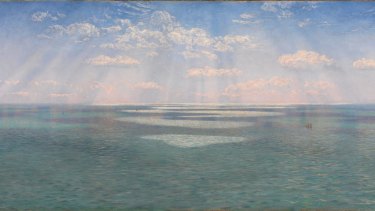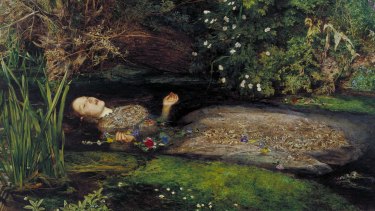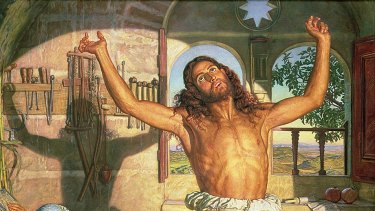Exhibition titles are like those advertisements that ask you to sign up for a course that will help you make millions or learn to speak another language in two weeks. Naturally, if you don't succeed it's always your own fault. With a show titled Love & Desire: Pre-Raphaelite Masterpieces from the Tate, at the National Gallery of Australia, if you find much of this work to be truly hideous it's your own taste that's to blame.
Can a work be a certified "masterpiece" and still set the viewer's teeth on edge? It could be argued that a masterpiece is a category sanctified by time and art history, regardless of individual responses. It would be easier to accept this idea if the word wasn't used in such profligate fashion by marketing departments.
John Brett’s The British Channel seen from the Dorsetshire Cliffs, detail (1871).
To expose my own taste in a way I usually try to avoid, I can't help seeing the phrase "Pre-Raphaelite masterpieces" as a contradiction in terms. When I look at the Pre-Raphaelites I see sentimentality, ponderous storytelling, unnatural colour and an obsession with detail and finish that sucks the life out of a canvas. What's more, they have always struck me as hypocrites and poseurs. Most of the group had no interest in religion but painted religious subjects as an attention-seeking gambit. When an artist did grapple with belief and doubt, as was the case with William Holman Hunt, the paintings showed a complete inability to think outside the parameters of his own culture.
In an attempt to imbue his religious paintings with the greatest possible accuracy Hunt undertook several journeys to the Holy Land beginning in the 1850s, but when he painted a new, larger version of his iconic, The Light of the World in 1900-04, he made Jesus Christ look more like a Scotsman than a Semite. It has been impossible for western artists to rid themselves of the fairytale idea that Jesus was a strapping, white lad with reddish-brown hair – at least until Pasolini's film, The Gospel According to St. Matthew, in 1964.
John Everett Millais’ Ophelia, detail (1851-52).
The three founding members of the Pre-Raphaelite Brotherhood in 1848 were Hunt, John Everett Millais and Dante Gabriel Rossetti. They were soon joined by James Collinson, Frederic George Stephens, Thomas Woolner and Dante's brother, William Michael Rossetti, who acted as scribe. This original association was to last only five years, but the influence of the Pre-Raphaelites would persist into the Edwardian period, drawing in dozens of fellow travellers. This is probably one of the reasons British art proved so resistant to Modernism.
The chief aim of the Brotherhood was to counter the historical tendencies of art from the high Renaissance onwards. As they saw it the problem began with Raphael and was exacerbated by Sir Joshua Reynolds, the first president of the Royal Academy. They argued that art had fallen into stale mannerisms, and called for a return to the brilliant colour and precise detail of the early Renaissance. In fact they knew little about Raphael and even less about the art they championed as a model.
The Pre-Raphaelites were the original rebels without a cause. Their most sacred goal seems to have been publicity, while their "revolutionary" program was aimed at taking art backwards. Consistency was not on the agenda. They flirted with the art and literature of the Middle Ages, but adored the Romantic poets. They approached their work as a form of painstaking illustration at a time when artists such as J.M.W. Turner and Eugene Delacroix were painting with a new freedom of expression.
If there is a "masterpiece" in this show, it would have to be Millais' Ophelia (1851-52), a picture that shows Hamlet's girlfriend floating dead in a forest pool. Millais almost managed to kill off the model, Lizzie Siddal, who caught a chill from lying fully clothed in a tub of water for hours on end. Nevertheless, it's a highly original conception and a staggering display of technique.
William Holman Hunt’s The Shadow of Death, detail, 1870-73.
Of all the Pre-Raphaelites Millais was the most talented, and in time would become wildly successful due to his mature conviction that an artist should give the public whatever it wants. In many anecdotes Millais' mind appears commonplace to the point of stupidity.
For all his artistic brilliance there are numerous paintings that make one want to laugh out loud. Exhibit A: The Awakening Conscience (1853-54), which shows a "fallen woman" in an apartment that has been fitted out by a wealthy lover. Sitting on his knee she has a sudden revelation that the path of sin must be abandoned. It's a vignette of modern sleaze transformed into a beacon of Christian sentiment. To underline the woman's status as a victim Millais includes a cat playing with a small bird.
It's an image that cries out for parody. Imagine a goggle-eyed Michael Cohen sitting on Donald Trump's lap.
The other painting in this exhibition with compelling claims to masterpiece status is J.W.Waterhouse's The Lady of Shalott (1888). A latecomer to the Pre-Raphaelite ideal, Waterhouse was a more natural painter than any of his peers, even allowing for his obsession with poetic and mythological subjects.
When I look at the Pre-Raphaelites I see sentimentality, ponderous story-telling, unnatural colour, and an obsession with detail and finish that sucks the life out of a canvas.
In Tennyson's popular poem the Lady of Shalott meets her doom by venturing outside her lonely tower and floating off in a boat in search of Sir Lancelot, for whom she has conceived an infatuation. The moral of the story was that women are frail creatures who should never leave home unsupervised, but Waterhouse doesn't try to turn his painting into a Victorian morality tale.
The Lady may be in medieval robes, her boat decorated with a lavish embroidery, but the picture is essentially a landscape painted in a naturalistic manner. Were the Lady shown in peasant garb digging potatoes, it might pass as a work by Jules Bastien-Lepage.
Speaking of landscape, the big surprise of this exhibition are the works of the underrated John Brett, notably a panoramic view of 1871 – The English Channel seen from the Dorsetshire Cliffs – in which the play of light on clouds and ocean is interrupted by one tiny silhouette of a boat.
If all Pre-Raphaelite pictures were so serene, so resistant to corn and make-believe, the group may have proved more resistant to the vicissitudes of art history.
As I absorbed the works of Hunt, Rossetti and the unspeakably mannered creations of Edward Burne-Jones, I couldn't help thinking that all these affectations arose much later than Gustave Courbet's A Burial at Ornans (1849-50), and contemporaneously with a picture such as Claude Monet's Impression Sunrise (1873), which will be the centrepiece of the next NGA blockbuster, to be held in June.
Courbet's painting was truly revolutionary in that it made a country burial into the subject of the kind of grand-scale work that had previously been reserved for kings and conquerors. Monet's painting, which gave its name, inadvertently to the Impressionist movement, was heavily influenced by the late paintings of that genuine English revolutionary, Turner.
For Hunt, Impressionism was to be viewed in moral terms as an abomination, an offence against God and religion. It was a nutty idea, but then Hunt was unorthodox in all his thoughts about art and faith. Rossetti may have been the greatest feat of self-invention among the Brotherhood, but Millais grew richer, and Hunt stranger with each passing year. Appropriately enough for a group with such literary leanings, the entire saga of the Pre-Raphaelites plays out like a rumbustious Bohemian comedy. If the art were a match for the stories and personalities this would indeed be a show of masterpieces.
Love & Desire: Pre-Raphaelite Masterpieces from the Tate is at the National Gallery of Australia, Canberra until April 28.
Source: Read Full Article


